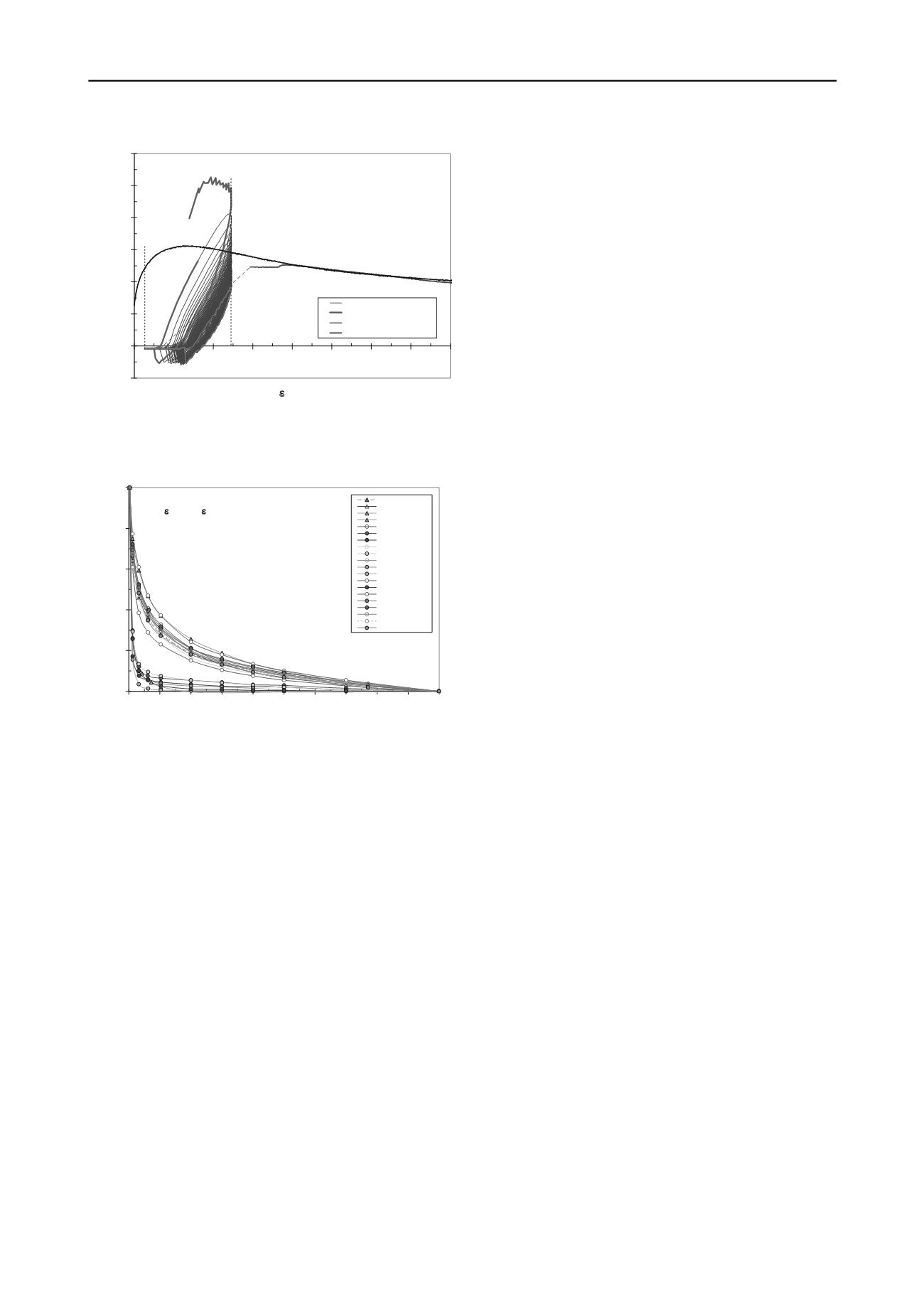
1414
Proceedings of the 18
th
International Conference on Soil Mechanics and Geotechnical Engineering, Paris 2013
Figure 5. Example of results from a strain-controlled cyclic test with
cyclic strains of two times the static failure strain with the specimen
after 1000 cycles subjected to a rest period of 1 hour followed by static
shearing as compared to that measured in an ordinary static test.
Figure 6. Illustration of how fast different types of clay are broken down
with number of strain-controlled cycles expressed as shear stress
reduction in relation to the total reduction after 100 cycles.
4 CONCLUSIONS
The investigation tried to simulate a case where a
considerable part of the available shear strength in clay is
already mobilized by static forces and cyclic loads or enforced
deformations are applied in addition. This is a common
situation in natural slopes and during the building phase of
many constructions. Other cases, such as earthquakes, wind-
and wave loads and other combinations of static and cyclic
stresses as well as other types of enforced deformations can give
very different results concerning the sizes of the stresses, strains
and deterioration of the shear strength (e.g. Andersen 2009).
Nevertheless, the general pattern for what soil properties affect
the behaviour and susceptibility for strength degradation can be
expected to be about the same.
The results generally confirm earlier indicative findings in
Sweden and Canada by Larsson and Jansson (1982) and
Tavenas et al. (1983) regarding influence of plasticity and
sensitivity, but the behaviour in different phases is here
investigated in more detail.
The general influence of different soil properties that could
be outlined from the results is by necessity simplified. To
discern the effect of the various parameters in greater detail,
more tests would be required and possibly also tests on artificial
soils enabling a more systematic study of the influence of
various parameters separately.
Tentative calculations made in connection with this project
show that high traffic loads, dumping of large boulders, rockfall
etc. in certain cases can result in large deformations and
significant strength reductions in the underground. Enforced
deformations that exceed the static failure strain always bring a
strength reduction.
-10
0
10
20
30
40
50
60
0
1
2
3
4
5
6
7
8
a
, %
t, kPa
Fultaga 6.5m-m1-P5-cycl2
1 cycl.
100 cycl.
Fultaga 6.5m-m1-P3-static
Fultaga clay
6.5 m
5 ACKNOWLEDGEMENTS
The investigation has been supported by grants from the
Swedish Transport Administration (initially its former branch
the Swedish National Rail Administration) and by internal
research funds at the Swedish Geotechnical Institute. The kind
support from Knut Andersen at the Norwegian Geotechnical
Institute by sharing his extensive knowledge and experience at
the start of the project is gratefully acknowledged.
6 REFERENCES
Andersen, K. H. 2009. Bearing capacity under cyclic loading – offshore,
along the coast , and on land
. Canadian Geotechnical Journal
, Vol.
46, No. 5, pp. 513-535.
0
20
40
60
80
100
0 10 20 30 40 50 60 70 80 90 100
Number of cycles
t
red
/t
red-100cycl
Mellösa 5m
Mellösa 8.5m
Norrköpng 5m
Strängnäs 6m
Torpa 3.5m
Torpa 5.5m
Torpa 8m
Onsjö 3.6m
Onsjö 7m
Äsperöd 2.7m
Äsperöd 7m
Kattleberg 8m
Munkedal 5m
Munkedal 10m
Gläborg 4.5m
Gläborg 6m
Gläborg 10m
Fultaga 6.5m
Fultaga 6.5m-II
Fultaga 10m
max
= 2*
f
Camitz, G. 1980.
Corrosion investigation in soils. Directives for
determination of soil resistivity.
Korrosionsinstitutet. Bulletin No.
88. (In Swedish)
DeJong, J., Yafrate, N., DeGroot, D., Low, H.E. and Randolph, M.
2010. Recommended practice for full-flow penetrometer testing and
analysis.
Geotechnical Testing Journal
, 33 (2), 137-149.
ISO 2004. ISO/TS 17892-6:2004,
Geotechnical investigation and
testing - Laboratory testing of soil - Part 6: Fall cone test.
.
International Organization for Standardization (ISO).
ISO 2012. ISO22476-1,
Geotechnical investigation and testing - Field
testing - Part 1: Electrical cone and piezocone penetration test
.
International Organization for Standardization (ISO).
Larsson, R. 1986.
Consolidation of soft soils
. Swedish Geotechnical
Intsitute, Report No. 29. Linköping.
Larsson, R. 1990.
Behaviour of organic clay and gyttja
. Swedish
Geotechnical Intsitute, Report No. 38. Linköping.
Larsson, R. 2011.
Effects of changes in pore water chemistry,
particularly leaching of salts, on the properties of natural clays. A
literature study.
Swedish Geotechnical Institute, SGI. Commission
Göta River. Sub Report 31. (In Swedish)
Larsson. R. and Jansson, M. 1982.
The Landslide at Tuve November 30
1977
. Swedish Geotechnical Institute, Report No. 18, Linköping.
Larsson, R., Åhnberg, H. and Löfroth, H. 2012. A new Swedish large-
diameter sampler for soft and sensitive clays.
Proc. 4th
International Conference on Geotechnical and Geophysical Site
Characterization (ISC'4
), Porto de Galinhas, Brazil. p.p. 737-742.
Lunne, T., Berre, T. and Strandvik.S. 1997. Sample disturbance effects
in soft plastic Norwegian clay.
Proc. of Recent Developments in
Soil and Pavement Mechanics
. Rio de Janeiro, pp. 81-102.
Rankka, K., Andersson-Sköld, Y., Hultén, C., Larsson, R., Leroux, V.
and Dahlin, T. 2004.
Quick clay in Sweden
. Swedish Geotechnical
Institute, Report No. 65, Linköping.
SGF 1993.
Recommended Standard for Cone Penetration Tests
.
Swedish Geotechnical Society, SGF, Report 1:93, Linköping.
Söderblom, R. 1969.
Salt in quick clay and its importance for quick clay
formation
. Swedish Geotechnical Institute, Proceedings No. 22,
Stockholm.
Tavenas, F., Flon, P., Leroueil, S. and Lebuis, J. 1983. Remoulding
energy and risk of slide retrogression in sensitive clays.
Symposium
on Slopes on Soft Clays
. Swedish Geotechnical Institute, Report
No. 17, pp. 423-454. Linköping.
Vucetic, M. 1994. Cyclic characterization for seismic regions based on
PI.
Proc. 13th International Conference on Soil Mechanics and
Foundation Engineering
, New Delhi, Vol. 1, pp. 329-332.
Åhnberg, H. and Larsson, R. 2012.
Strength degradation of clay due to
cyclic loadings and enforced deformations
. Swedish Geotechnical
Institute, Report No. 75, Linköping.


